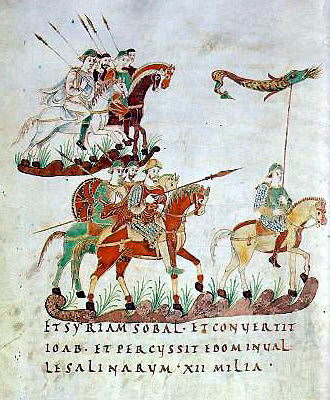
Carolingian cavalry
TRACES
of
ALANS and SARMATIANS
in
EUROPE
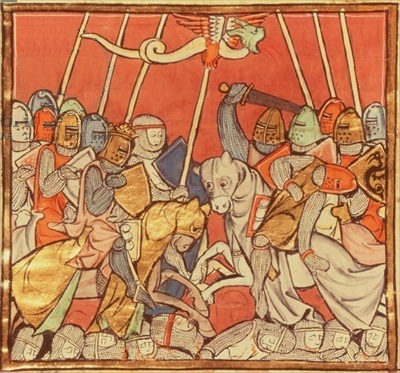
The battle of Bedigran

Carolingian cavalry |
TRACES
|

The battle of Bedigran |
*
*
Original Residences
|
|
The original residences of the Sarmatians were in the South Russian steppes between the Danube and Don. The Alans lived more to the east, behind the Don, the Black Sea and the Aral Sea in Kazakhstan and Uzbekistan. Shortly before the beginning of our era started the first contacts of Sarmatians and Alans with the Roman and Persian Empire. The Romans called them barbarians, a term also used for Germans because of what they called their babbling language. In the Hungarian PlainIn the first century before our era they moved westward. The Sarmatians took in possession the area between the Black sea and the Danube with their greatest concentration in what is now the Hungarian Plain. From then the Romans called this area Sarmatia. The Alans took the places that the Sarmatians had left and founded a kingdom along the Don and the Crimea, also called the Empire of the Bosporus. This Bosporus is not to be confused with the Bosporus near Constantinople. |
Mercenaries in the Roman LegionsAlthough often are mentioned the clashes between Romans and Barbarians, there were during much longer times good relationships with mutual trade. Their leaders entered into treaties with the Romans. In such a treaty, foedus, they concluded to become allies and agreed to provide troops for the Roman legions. (1) In the years 174-175 is the Sarmatian war between the Roman Empire and the Sarmatian Iazygs who live in Sarmatia under King Barnadaspos. In the peace treaty, foedus, concluded between the Roman emperor Marcus Aurelius and the Sarmatian King Barnadaspos is regulated that the Sarmatians will provide a cavalry army of 8000 man for the Roman legions. Of these 1,500 are stationed in Italy and 5500 in Great Britain. At he end of the 4th century a group Alans joins the Roman army as comitatenses Alani as imperial cavalry under the Roman general Stilicho to fight against invading Goths, who were helped, and that was no exception in that time, by other Alans. Notitia DignitatumAbout the stationing of Sarmatians and Alans in the Empire is little written. There is one contemporary document dating from the 5th century the Notitia Dignitatum. This is a list of dignitaries and gives an overview of all administrative and management functions and of the insignia, banners in the Roman Empire. It also describes the praefecti of Alans et Sarmatians. The Notitia mentions in the beginning of 5th century twenty-four praefects of Sarmatians whereof seventeen in Italy and six in Gaul. In Gallic Velay was a praefect of Sarmatians and Alans, in Poitiers of Sarmatians and Taifals. In England was a praefect at Ribchester (Lancashire). The list is surrendered incomplete, the praefects in Germania Secunda, the Benelux region, is partially missing. Known at least is the Praefectus Laetorum Lagentium prope Tungros. This praefectura was in the old civic center Atuatuca close to the castles on the Meuse transition, Traiectum ad Mosae, Maastricht. The recently discovered oppidum of the Aduatuci in Thuin (Hainaut) is also a possible place, but this seems to be of older date. A praefectus was during the first centuries mostly a Roman but since the army reform of Emperor Diocletian (284-305) the allies, foederati, Germans, Batavi, Sarmatians and Alani were led by a own leader. A comes, general or magister Equitum, commander in chief. Comitatenses, plural of comitatensis, were imperial troops. Since the 4th century comitatenses were stationed at strategic locations in the interior, from where they could go up against invaders. They functioned also as bodyguards of the emperor on his campaigns. De border troops limitanei were encamped in a stone castella of castra. In the 5th century between 420 and 471 Alans had high posts the in the Eastern Roman Empire, as Ardabur and his son Aspar. These were Alanian nobles that were included in the aristocracy of the Empire. They and their descendants and staff remained in and around the current Istanbul in Turkey. * Settlements of Veterans and newcomersNorthern ItalyIn the year 358 AD the servile Sarmatian tribe the Limigantes came in revolt against the leading tribe, the Argaragantes in an internal Sarmatian war and they expelled their masters. These warrior nobility received a warm welcome in the Roman Empire and got settlements for them and their families to the number of 30,000 in different provinces in the heartland of the Empire in Thracia, Macedonia and Northern Italy. Sarmatians and Alans had many small military colonies in the Po Valley. The last mentioned Alanian regiment in the Western Roman Empire was that at Ravenna in 487, nine years after the dethroning of the last Western Roman Emperor Julius Nepos in 480. They took part in the election of the Ostrogoth Odoacer to emperor and served in his army. During the last raid in Hungaria by the Hun Baba´ in 470 a group of Sarmatians crossed the Donau (Danube) and settled in Pannonia Secunda in Singidinum (Belgrade). Baba´ was then slain by the East Roman emperor Leo I. In 568 Sarmatians still lived there and some followed the Longobards into Italy and settled in the Po Valley. 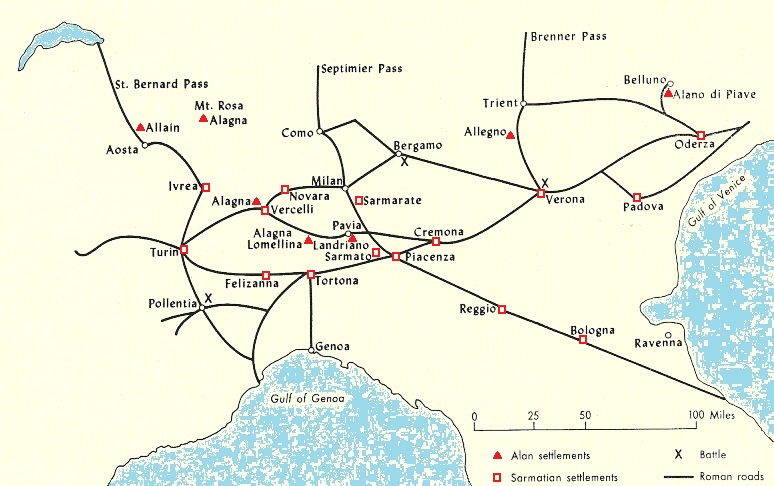
Settlements of Sarmatians and Alans in Northern Italy. (2) * In Central EuropeEmperor Valentinian II (375-392) strengthened the borders of Pannonia by concluding new treaties foedera with the Sarmatians and Goths and offers them settlements on the Roman side of the Danube in Pannonia. It is mentioned that the majority of the Sarmatians was still living east of the Don. Sarmatians stayed in the Pannonian Plane still after the time of the Hun invasions. In 470 was the last raid of the Hun Baba´ in Pannonia Secunda. * Gallia |
|
The poet Ausononius sees on a journey in the year 368 in the Mosel valley a recent built village of peaceful Sarmatian farmers. King Sambida accepted in 440 a settlement in the valley of the Rhone at Valence. In Valence (Fr.) in the Rh˘ne valley are graves found from the 4th century with skulls as seen in the Ukraine in steppe peoples such as Sarmatians and also Goths with a characteristic skull deformation, caused by tight bandage of the growing skull of new born babies. (3) In Brittany king Eochar got in 447 his own country. In an area around Lake Geneva are many places with names of Alanian origin. These must have been Alanian settlements. Here are also graves from the 5th century of people that have the same typical Sarmatian skull deformation. |
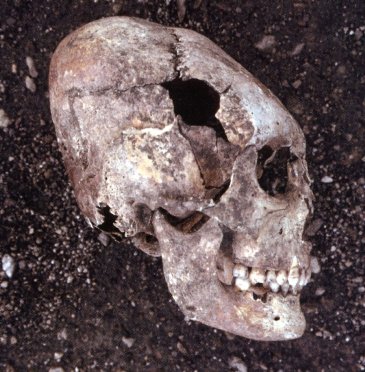
Gothic egghead skull, in youth deformed,
|
|
In graves in Valais (Sw.) 5th century, and Valence (Fr.) 4th century, skulls are found, the same as found in the Ukraine, with the characteristic skull deformation, caused by tight bandage of the growing skull of new born babies as seen at the steppe peoples as Sarmatians. (4a) |
|
The necropolis of Obernai (Alsace, Bas Rhin, France) is one of the few important groups discovered in France and it demonstrates for the first time the treatment of an Eastern community in Alsace at the end of the Roman Empire. These Merovingian necropolis consists of eighteen burials oriented west/east. Three contained silver earrings. One contained two small gold pins on the chest of the deceased, which may have fastened a garment such as a veil. A chatelaine was connected to a belt with various objects attached including a silver mirror, similar to those used by the Alano-Sarmatian populations of the Caucasus, a tweezer set and several large colored glass beads and amber. This female also had a triangular antler comb, decorated with geometric motifs and horse heads at either end. |
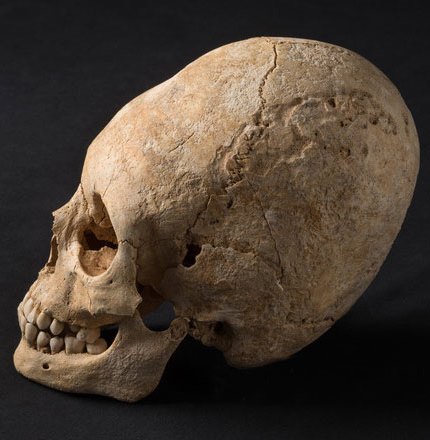
Distorted skull, necropolis in Obernai, Bas-Rhin. (4b) |
|
Besides the grave goods, the eastern origin of the individuals is attested by the presence of an intentionally deformed skull. Burials such as this have been discovered in isolation in northern Gaul, Germany and Eastern Europe and often include rich furnishings. They would appear to represent the graves of dignitaries and their families who were incorporated in to the Roman army at the time of the great migration. In 442 The Roman commander in Gaul Fl. Aetius asked the Alanian king Goar, probably a son of the previous Goar, to come to Orleans and to keep the rebellious native population under control. Goar got there a country at the Loire with the capital Orleans. His followers took the estates between Orleans and Paris. Many places that now bear names of Alanian color. Many Places in France, also in Northern France in the Ardennes, bare names as Alaincourt, Alland'Huy, Aillainville, Sampigny, Sermaise etc. that remind former Alanian settlements. 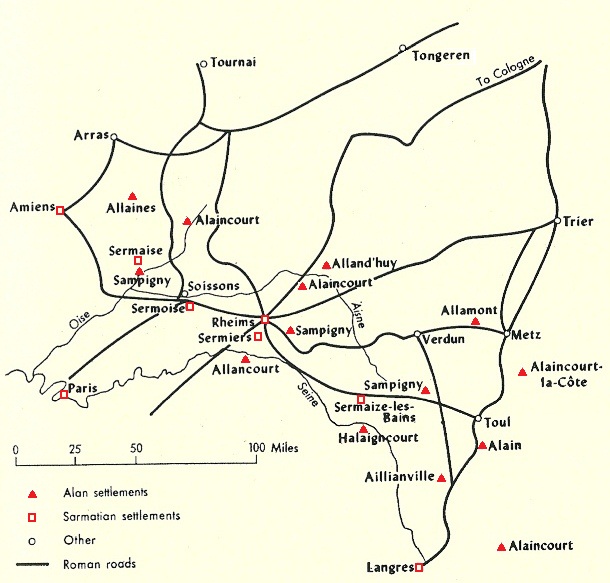
Sarmatic and Alanian settlements in North-East Gallia (5) * On the northern bordersAfter the internal Sarmatian war in 358 the leading tribe, the Argaragantes the warrior nobility 30.000 in number received asylum in the Roman Empire and were given settlements in different provinces, Thracia, Macedonia and Northern Italy. In 401 the Hun Alaric invades the Roman Empire. The majority of the Roman civilian population of Pannonia flights. Many Sarmatians and Alans led by their king Candac are installed in the Eastern Roman Empire. Alans are placed south of the mouth of the Danube in Scythia Minor, now Northeast Romania, and the Sarmatians got settlements in Moesia at the current Kula in Northwest Bulgaria. The Hun Attilla settles in 433 with the consent of the Romans in Pannonia. After his death in 453 his empire falls apart. The vast majority of the Huns, who were ultimately composed of a multitude of ethnic groups, retreats to the Black Sea where sill live Sarmatians. In the late Sarmatian graves in that region one finds Hunnic influences. In 470 are still listed Sarmatians in Pannonia who defended them against by migratory Ostrogoths. In 529 pull some of them with the Longobards to Italy. (6) Round 450, in the time of the raids of the Hun Attilla groups of Sarmato-Alans were installed under their leader Candac as Foederati in the Danube valley in Little Scythia, now Bulgaria. When the Roman Empire at the end of the fifth century imploded and the legions were withdrawn to Italy, the foreign veterans who always received land as a reward for their military service, will have stayed at the place where were stationed and had lived with their families, that was at the borders of the Empire. Their offspring will be merged into the resident population. 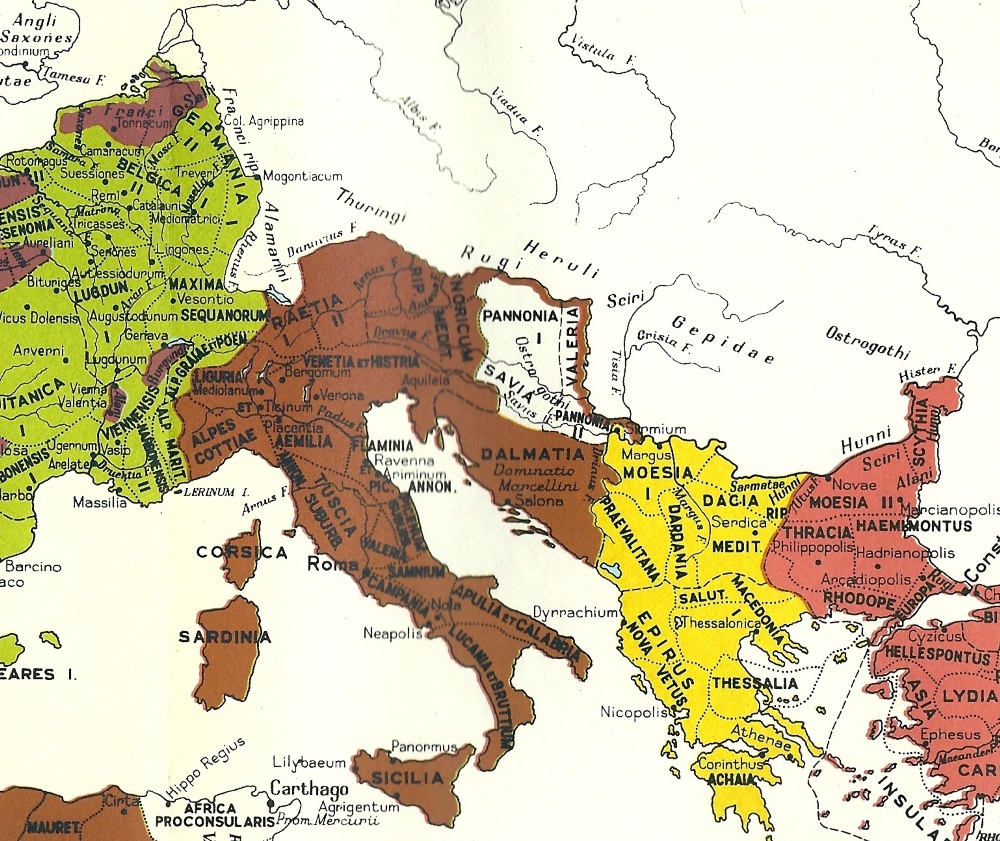
De Northern borders of the Imperium Romanum Anno 454 (7) * Great BritainThe cavalry that in the third century in Britannia, Great Britain, was stationed is after a short time withdrawn, but one company, the ala prima Sarmatarum, stayed and was finally stationed in Bremetenacum Veteranorum, located near current Ribchester in Lancashire. Here they settled with wives and children. there are archaeological finds. (7a). The best known is the cenotaph in Chester. See for this the story of King Arthur. * The Great Migrations in the 4th centuryTo the CaucasusAs a result of the invasion of the Huns in the last quarter of the 4th century, the Eastern part of the Alans migrate south into the Caucasus and settle permanently in what became the kingdom Alania and now the republic North Ossetia-Alania. To Western EuropeThe western group Alans goes to the west and divides in multiple parts. One group joins around 400 a group Visigoths and invade Italy. In 402 they where defeated in Raethia by the Roman general Stilicho. Then they become foederati, allies, of Rome and join the Legions. Other groups migrate along the Danube together with the likewise by the Huns expelled Vandals, Burgundians, Suebes and Quads. They cross the Rhine and invade in 406 Western Europe where they divide into at least two groups. One group under Goar set itself also under the authority of the Roman emperor and is included in their legions in Gallia. Others under Respendialis march some years though Gallia and invade about 409 into Spain. They live here twenty years and are then driven out by the Romans and go in 429 to North Africa. With the Vandals they found the kingdom of Vandals and the Alans in Africa with the capital Carthago. 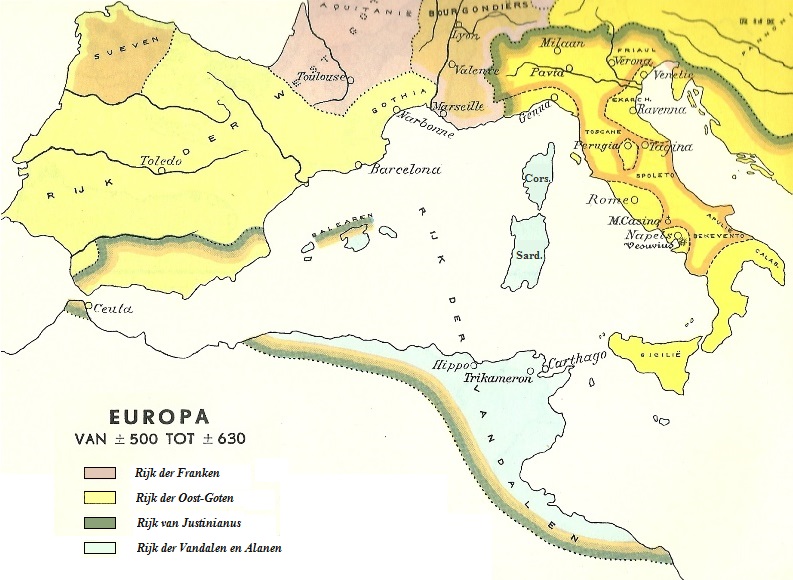
The Kingdom of the Vandals and the Alans in AfricaOver more than a century from 429 till 535 they form the most dominant kingdom in the Mediterranean. In Africa, the present Tunisia and Algeria, are fertile fields that since a long time supply the grain for Rome and Italy. They conquer all coasts and islands in the western part of the Mediterranean, included Sardinia, Corsica, the Balearics and Sicily. This empire is during the fifty years reign of king Geiseric the most powerful kingdom in this region. They dominate also great parts of the mainland of Italy, Greece and all the Greek islands. At a very old age dies king Geiseric in 477. The empire endures till 535. Hereafter it is incorporated into the Byzantine Empire. Their former towns on the Iberian Peninsula that were overcome by the Goths live on under the name Got-Alania now Catalonia. (8) * Were the leaders of the Franks Sarmatians? |

Carolingian cavalry
|
The Germanic Cugerni or Sicambri, were also called Franks. They lived since the time of Caesar east of the Batavi. They were settled in the first century in the Roman province Germania inferior, later Germania secunda, in Colonia Ulpia Traiana near modern Xanten upstream of Nijmegen, east of Venlo. In this region were also stationed Sarmatians as limitanei, border troups. They came originally from the Danube Plain. They and the Franks were by treaties associated with the Romans as foederati and defended the borders. In the middle of the 5th century, they were retired to the south and settled in Fanum Martis, now Famars. (8a) Childerik, ▒ 440-480, the first known Frankish king, was in the same time by the Romans assigned to a large area in Tournai. His tomb was discovered in 1652 in the church of Saint Brice and therein were except Germanic also clear Sarmatian marks. |
|
Childerik was a son or at least a descendant of the semi-legendary king Merovech. From Merovech recounts a legend that he is the son of a princess and a sea monster. This shows similarities with the Sarmatian Nart saga. The ancestor of the main gender the Urismag sprung from the commitment of progenitor Achsartag with a sea nymph, daughter of the sea god Donbettir. Clodovech, called by the French Clovis, son of Childeric was leader of probably 500 Franks. Him was given the command of Roman units of allies Sarmatians and Alemanni and he married Clotilde Burgundian princess who had the catholic religion. Clodovech and his entire court took the over the Christian faith, in that way he got the mighty bishops on his hand. He lost however as a result the half his Frankish followers. The conquest of the important city Soissons showed his growing power. The military settlers of other origin assimilated unnoticed with the Franks. (9) An example of the assimilation of the Alans, mainly that in Armorica the later Brittany is demonstrated by the disappearance of the tribal name Alan together with the appearance of the first name Alain. That name is even very popular until now also in the English territories. Even the name Goar remained. After the Christianization of the Alans, which took place about the same time as that of the Franks, we see in the sixth century a bishop and a Saint Alanus and also a St. Goar. A variant name is Eochar. This sometimes occurs alternately in the same person. In the Ossetian, the language of the eastern Alans, the name Goar Changed to IŠukhar. Another Goar is mentioned in 627 as Count of Albi in Aquitaine and succeeded in 630 St. Arnulphus, the oldest known forebear of the Carolingians, as bishop of Metz. This indicates at least a close relationship between the Sarmatian and French nobility and also the settling of Sarmatians or Alans in Aquitaine. The German historian Schmoeckel sees much evidence that the Merovingians and other Frankish nobility as the Carolingians are descendants of the Sarmatians. (10) The latest synthesis of the history of the counts of Limburg shows as the starting point the construction around 1030 of a castle on a cliff above the river Vesdre now called Limbourg sur Vesdre, in an area that was part of a vast and ancient Carolingian domain. This area was since the beginning of the eleventh century in the hands of Count Frederick of Luxembourg, Count in the Mosel Shire. |
|
His family owned in this region, especially in Maselant, more counties. The name Limburg is derived from the draco wind-sleeve banner Draco castle and refers to the connection with the Salian imperial dynasty. Here again, the Draco banner name resurfaces as a symbol of the Salian Franks. The pretended descandants of the Sarmatians. (10a) |
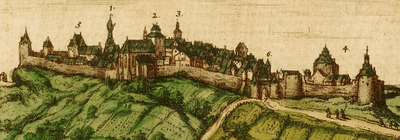
Limbourg sur Vesdre |
|
* The Nibelungen a Burgundian sagaFrom this time, the fifth century, date the events recounted in several epics as the Edda and the Nibelungen. The epic of the Nibelungen is first recorded in Passau on the Danube around the year 1200. It recounts the Dutch hero Siegfried (Zegevrijt) of Xanten, who defeated the Snake Dragon (Ribbon Dragon) and by the bath in his blood had become invulnerable. The ribbon dragon seems to be a metaphor for the drago, the wing- and legless dragon that the Sarmatians had as standard and field character. Sarmatians were encamped in that time on the Rhine near Xanten. Siegfried conquered the land and the treasure of the Nibelungen on the edge of his empire. Regarding Nibelungen is thought to Niviella the current Nivelles. Siegfried went to the court of Gundahar, king of Burgundy at Worms to marry his Sister Kriemhilde. The father of Gundahar was king Dankwart and an influential uncle was called Hagen of Tronje, which is akin to Traiana, another name for Castra Vetera located near Xanten. Betrayed by his envious sister-in-law Brunhilde Siegfried is murdered by Hagen. His widow Kiemhilde then marries King Etzel, the Hun Attila, who had in Pannonia. now Hungary his capital. The wedding turned into a massacre between Huns and Burgundians. (11) * The Alanian origin of the Legends of King Arthur and his Knights Table
|
|
5,500 of them formed the sixth legion Victrix, that was sent to Britain. They are placed at the northern border of the Roman Empire near on Hadrian's Wall, the barrier against the Picts and Saxons. Later they were largely withdrawn from Britain. One company, the Ala prima Sarmatorum stayed permanently in England and during a long time a great Sarmatian colony of soldiers existed in Bremetenacum Veteranorum, at current Ribchester in Lancashire where veterans were given land and settled with their wives and children in the 4th century. In this region are Sarmatian tombstones preserved. (11a) Besides these archaeological remains are to date still present their myths and legends. the same as those that survived at other descendants of the Sarmatians in other counties of Europe as in northern France and in North Ossetia-Alania, where live the descendants of the East Alans. In this remote country survived the story Cycle of the Narts. The hero in the Ossetian tale Batraz lives on in the British King Arthur. The legends surrounding Arthur and his knights are interlard with the myths of the Nart cyclus. |
.gif)
Sarmatian tombstone
|
|
In old English chronicles Arthur is named a Celtic-Roman army chief. It is assumed that he could be the Sarmatian praefect Lucius Artorius Castus. The legendary King Arthur is mentioned by name for the first time as Gwawrddur in the heroic poem Gododdin, a South Scottish clan that was defeated by the Saxons in 600 in the battle of Catreath, just north of the Hadrian wall. There are multiple versions handed down of the legends surrounding King Arthur and his Knights Table. They date all from the later Middle Ages and all show very much agreements with the Alanian Nart saga. These to the British soil brought stories about the Caucasian hero Batraz lived also in Brittany and Normandy and the Loire valley, where descendants of the Alans lived. Here Lancelot takes partly the place of Arthur. In the Nart saga is spoke of a large magical scale the Nartyamonga that appears on their banquets and always fills itself again after emptying. Only the most impeccable heroes are allowed to drink out it. In the Arthurian legends, this is the Grail, from which only the noblest knights may drink. According to ancient texts, he was brought from Rome to Britain by a certain Alan. The grail gets from the 12th century Christian Association. (13) |
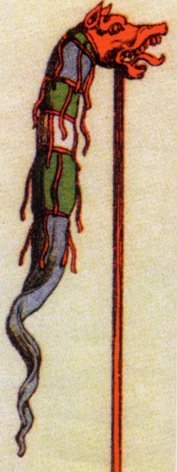
Sarmatic draco banner |
In an illustrated manuscript from 1290 King Arthur conducted in a battle the Sarmatian wind-sleeve standard in the form of a serpent. In the battle of Bedigran Merlin also wore this standard in his fight against rebellious kings who cooperated with the invading Saxons. The Sarmatians worshiped a god a sword that was stuck into the ground or in a woodpile. An obvious fact is that the young Arthur before he |

Merlin with Draco Banner at the Battle of Bedigran.
|
|
became king, draws a sword from a rock and thus proves his right to the throne. Later other knights of the round table repeated this act. Arthur wore as king the magic sword Excalibur. It is clear that this means that this sword was forged by a Kalyber a member of the Kalybers the Sarmatian tribe of the that lived in the Western Caucasus and was the most famous in the forging of weapons. In the Nart saga it was a use that at the death of a prince his sword was thrown into the water. Both Arthur as the Nart prince Batraz had to repeat tree times their request before it was implemented. (14) Excalibur - War God of Sarmatians and Alans |

|
|
* The names Goar and AlainGoar is a famous Alan king name. King Goar and his followers went in Roman service in 407 AD. In 411 king Goar and the Burgundian king Gundahar, proclaim at Mundiacum in Germania Secunda the Roman aristocrat and general Iovinus in 411 as emperor. In 442 a king Goar is requested by the Roman commander in Gaul Fl. Aetius to come to Orleans and hold under control rebellious natives. Goar and his people settled after that in this region at the Loire and have their capital in Orleans. Another Goar was in the year 627 in Aquitaine Count of Albi and succeeded in 630 as bishop of Metz St. Arnulphus, the oldest known forebear of the Karolingians. This could be an indication of a family relation. An example of the assimilation of the Alans may be the appearance and later the popularity in Europe of the first name Alain. In Pakistan there is a city Goar, a family name Goar and even a bean named Goar. It is interesting to find that relationship. |
|
* DNASarmatians are disappeared as a people and are merged in the European population. However, a group of them, the eastern Alans preserved their identity till today. These are the current inhabitants of North Ossetia-Alania. They came from the lower reaches of the Don and settled in the Caucasus at the time of the Great Migrations in the begin of our era. The nobility of the Sarmatians formed the live guards of the emperors in the fourth and fifth century as Constantinus and Constant, who no longer resided in Rome but in the big new towns in the Northern and Eastern parts of the Empire. We have to look after the genetic traces of progeny of the Sarmatian nobility around that places. Sarmatian cavalarists served in the Roman legions. Veterans settled in Italy, Gallia and on the Northern borders of the Empire in England, Belgiun, Germany, Austria. Perhaps there their DNA will be found there in the population or in archaeological remains. It must be considered that before the beginning of our era they lived in South Russia and consisted of many tribes. Conquered peoples were often admitted into their midst and they were related to the Alans.
Alan and Sarmatian DNA.* To write this article, a number of recent and classic works were studied. (18) |